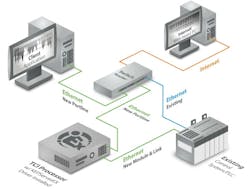A "Cooler" Solution with OPC
Advanced Monitoring Technologies Inc. (AMT), in Keswick Ridge, New Brunswick, Canada, provides cost-effective control solutions with energy-saving control logic for refrigeration plants and ice arenas. The company is on the cutting edge of energy-saving technology and was recognized by Canada’s National Research Council in 2003 as a finalist for the Canadian Innovation Award for Sustainable Development.
AMT’s TechCold refrigeration system has two main purposes. The first is to cause a substantial reduction in energy consumption and demand. The second purpose is to provide a standardized system that is common to all of a company’s plants, resulting in reduced implementation and servicing costs while providing ongoing remote monitoring and upgrade capability. The TechCold refrigeration system comes in two varieties—TechCold Modular (TCM), for plants without centralized control, and TechCold Integrated (TCI), for plants with existing centralized control.
Because most plants already have control systems with input/output (I/O) schemes, AMT’s goal in designing its TCI system was to have it interface seamlessly with almost any controls manufacturer. Device communications within an industrial climate can be daunting; there are a myriad of device manufacturers and communication protocols. Although AMT had the capability to develop communication drivers, it knew this would be a distraction from its core business, which is developing quality control algorithms for the reduction of energy usage within refrigeration systems.
AMT realized early that the best way to achieve its design goal was to implement OPC client capabilities into its application software, then connect to third party OPC servers to interface with customer control systems. AMT decided to standardize on OPC servers from Kepware Technologies, based in Yarmouth, Maine. The KEPServerEX application is a single OPC server with driver “plug-ins” for hundreds of programmable logic controllers (PLCs) and devices, and would allow the TCI system to connect to the widest variety of control systems.
To develop the TCI control system, AMT teamed up with a respected multi-national food-processing firm to develop a prototype that would integrate AMT’s high-end control algorithms with the customer’s existing PLC-based controls infrastructure. This firm gave AMT access to one of its plants for integration and testing over a two-year period.
The diagram included with this overview shows how a typical configuration allows for parallel operations flow between the existing control system and the TCI system. The existing PLC-based system still performs the alarm and housekeeping chores while the TCI system performs the higher-end modulations and activations of the equipment. All TCI operations are application programs written within the industrial personal computer-based processor. KEPServerEX is installed on the TCI, and communicates with the existing PLC controls by means of a transmission control protocol/Internet protocol (TCP/IP) Ethernet connection. Another Ethernet port allows access to remote clients within or outside the plant and also permits system operations to be viewed by means of an Internet browser.
AMT’s TCI system is successfully operating within several plants, with many other plants scheduled for implementation. According to AMT’s President, Ernie Adsett, “By standardizing on Kepware's OPC server, we are able to connect to a wide variety of PLCs and control systems without the need to make significant changes in our application. This saves us time and money on every application, and allows us to focus on and optimize our control algorithms for the customer.”
For more information about OPC solutions from Kepware Technologies, visit www.kepware.com.

